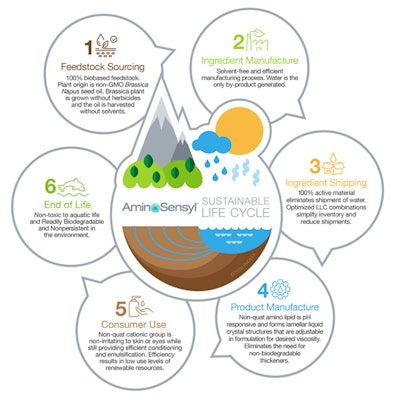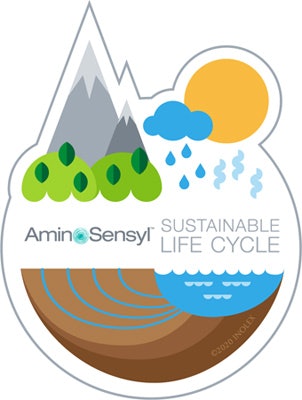
100% natural, safe for aquatic life, COSMOS certified, readily biodegradable and plant-powered are all consumer-desired claims that can be achieved by replacing quaternary ammonium technology with AminoSensyl HC. As the hair care industry moves to more natural and sustainable products, this technology is a core ingredient to deliver the performance, safety and environmental benefits consumer expect and brands promise.
The Issue with Quats
Quaternary ammonium compounds, or “quats” such as behentrimonium chloride are widely used in shampoos, conditioners, skin care and hair treatments. Quats have a permanent cationic charge which is beneficial when it comes to adhering to hair and skin but there are some issues associated with the permanence and strength of that charge when it comes to safety and sustainability.
- Quats can be irritating to skin and eyes because the molecule adheres so strongly to cells.
- The permanent cationic charge remains in the environment at the ingredient’s end of life stage and can adhere to microorganisms, invertebrates and fish, resulting in toxicity to aquatic life.
- These molecules are persistent in the environment and the longer they persist, the more potential there is for the toxicity to harm those ecosystems and organisms.
- There is always a component of a quat molecule, the quaternary ammonium group, that must be sourced from a petrochemical feedstock.
The Sustainable Life Cycle of AminoSensyl HC
INOLEX designed a functional cationic that solves for some of the sustainability issues of quats. AminoSensyl HC maintains the functional benefits of a quaternary component: conditioning and smoothing hair, defining curls, strengthening hair and creating lamellar gel networks. However, it has a better sustainability profile throughout the life cycle of the ingredient. INOLEX evaluates ingredient life cycles at six stages from feedstock sourcing through end of life.

1 – 6 stages of Aminosensyl Life Cycle
- Feedstock Sourcing: The molecule contains 100%-certified biobased content and is derived from non-GMO brassica seed oil.
- Ingredient Manufacture: The process of making AminoSensyl HC consists of a one-step, simple esterification. The reaction does not involve solvents, is highly atom efficient, and the only byproduct is water.
- Ingredient Shipping: The ingredient is delivered as a solid, 100% active material in convenient pastilles. No water or non-value-added material is shipped.
- Product Manufacture: AminoSensyl HC is pre-neutralized for ease-of-use and processing simplification. This technology can also eliminate the need for non-biodegradable thickeners.
- Consumer Use: The molecule is non-irritating to skin or eyes while still providing efficient conditioning, repairing and emulsification benefits.
- End of Life: AminoSensyl HC is non-toxic to aquatic life, readily biodegradable, and nonpersistent in the environment.

Aminosensyl life cycle
Quaternary ammonium compounds, or “quats” are an ingredient category to watch for potential scrutiny by consumers. That scrutiny will come for good reason: there are environmental concerns with quats and there are alternatives in the market that have better environmental profiles while accomplishing the jobs of quats. Specifically, AminoSensyl HC is a non-quat cationic conditioning system from INOLEX. This 100% natural system can enable formulations that are overall better for the environment and will not come under concern by consumers.
Disclaimer:
The above paid-for content was produced by and posted on behalf of the Sponsor. Content provided is generated solely by the Sponsor or its affiliates, and it is the Sponsor’s responsibility for the accuracy, completeness and validity of all information included. Global Cosmetic Industry takes steps to ensure that you will not confuse sponsored content with content produced by Global Cosmetic Industry and governed by its editorial policy.










